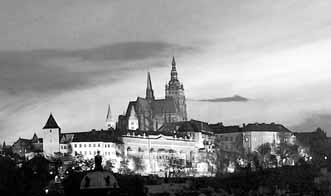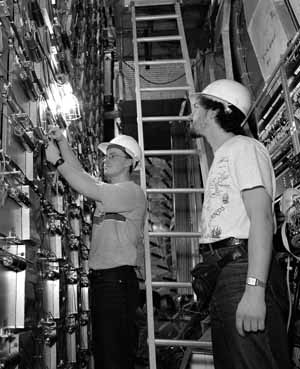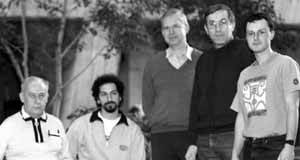 |
|
Prague Scientists Check in at Fermilab by Chad Boutin
Czech physicists now form a lively group at Fermilab's DZero. But for many Cold War decades, scientists in Prague were isolated from their Western colleagues.
"Fermilab was like Jupiter for us," said Ivan Wilhelm, Charles University rector and himself a nuclear physicist. "We knew it existed, but we couldn't reach it."
Researchers from three Prague institutions--Charles University, Czech Technical University, and the Academy of Sciences of the Czech Republic-- are now fully engaged with the community at DZero, contributing to the experiment and to the education of future scientists.
"The Prague group has been right up to speed with us from the outset," said John Womersley, spokesman for DZero. "It's as though there had never been a barrier between us at all."
Building a Collaboration
"Our forays in antiproton physics began many years ago, in the 1960s," Simak said. "After our work was completed at Dubna, Serpukhov, and CERN, we wanted to continue our studies at Fermilab."
While the proton's basic substructure is known, researchers would like a better picture of how its three quarks (up-up-down) and multiple gluon pairs interact. The Prague group's expertise in antiproton physics made them good candidates to help build the muon, silicon and forward proton detectors at DZero.
"When protons and antiprotons collide head-on, the high energy produces a shower of new particles flying off in all directions," Womersley explained. "But when they merely strike glancing blows off each other, nothing new is produced--they just fragment into their constituent particles, which continue to move more or less along the beamline, like buckshot out of a gunbarrel."
Beside the proton detector, the Prague group has contributed to other pieces of the DZero detector.
"The Czechs are excellent collaborators," Womersley said. "A huge experiment like DZero is like a small town--the butcher and the baker have to contribute to the overall welfare if the community is to thrive. The Prague group has paid its taxes by assisting with the muon and silicon detectors."
These two detectors, which respectively form the outermost and innermost layers of the DZero assembly, proved both technically and financially challenging to construct. Because the muon detector required a formidable number of parts, one problem was manufacturing the components at a reasonable cost. The Czech group's ingenuity helped solve it.
"I remember visiting their facilities in Prague," Womersley recalled. "They had taken over an old bus garage to build detector parts. They are good at using what's available to get the job done."
Although computer facilities in the Czech Republic are similarly limited, the group has made efficient use of them as well.
"The two Linux farms in Prague and Brno are a small portion of the computing resources that DZero needs," Womersley said, "but the Czechs have used them to test the software we use to reconstruct particle collisions. They have also contributed millions of lines of programming."
Put it all together and it's a lot for 10 physicists and graduate students to handle. But it is this overlap of commitments that gives the group members a global perspective on DZero.
"What impresses me about the group is their involvement in all aspects of the experiment," Womersley said. "They have provided technical manpower for assembly, and their physicists have tested the gear. They have done great work."
Training for the Future
"I have been here since 1997," Soustruznik said, "and Sasa since 1999. Since then, we have been helping assemble the central muon detector, but we have to devote some of our time to writing software for the Linux farm as well. And then there's our dissertations. It all keeps us busy."
Soustruznik is analyzing top quark data collected from Run I, while Kupco will use Run II data to investigate proton structure. But it is their exposure to all aspects of detector management that will most benefit their future in high-energy physics. Ivan Wilhelm has also brought this philosophy to his own classrooms over the years.
"It is important to give opportunities to young people," Wilhelm said. "It is necessary to have a theoretical background, but then you must apply it to experiments. When it is possible to show students every aspect of how a detector works, it builds continuity with the future. They will know how to manage a big experiment of their own someday."
With this outlook, the Prague scientists have forged alliances at DZero and with the international scientific establishment, which recognizes their prowess.
Funding is an especially tricky issue in Central Europe, where national economies remain in transition. But having arrived at Fermilab, the Prague group is planning an extended stay.
"The experiments at CDF and DZero are challenging ideas and theories in high-energy physics," Simak said. "It is exciting and we are glad to be a part of it."
On the Web:
|
| last modified 6/4/2001 by C. Hebert email Fermilab |
FRLsDFx9eyfrPXgV
 The particles could travel, but the particle physicists couldn't.
The particles could travel, but the particle physicists couldn't.


 "Thanks to funding from the NSF and Michigan State University as well as the Grant Agency of the Czech Republic, our work here got off to a good start," Simak said. "We are also receiving funds from the newly created Center for Particle Physics in Prague."
"Thanks to funding from the NSF and Michigan State University as well as the Grant Agency of the Czech Republic, our work here got off to a good start," Simak said. "We are also receiving funds from the newly created Center for Particle Physics in Prague."